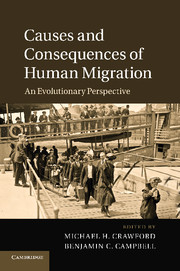Book contents
- Frontmatter
- Contents
- Contributors
- Preface
- 1 Perspectives on human migration: introduction
- Section 1 Theory
- Section 2 Geography and migration
- 8 Population structure and migration in Africa: correlations between archaeological, linguistic, and genetic data
- 9 Human migrations in North Africa
- 10 Identity, voice, community: new African immigrants to Kansas
- 11 The African colonial migration into Mexico: history and biological consequences
- 12 Demic expansion or cultural diffusion: migration and Basque origins
- 13 Consequences of migration among the Roma: immunoglobulin markers as a tool in investigating population relationships
- 14 Migration, assimilation, and admixture: genes of a Scot?
- 15 Mennonite migrations: genetic and demographic consequences
- 16 Human migratory history: through the looking-glass of genetic geography of Mycobacterium tuberculosis
- 17 Peopling the Tibetan plateau: migrants, genes, and genetic adaptations
- 18 Migration, globalization, instability, and Chinese in Peru
- 19 The great blue highway: human migration in the Pacific
- 20 Migration of pre-Hispanic and contemporary human Mexican populations
- 21 A review of the Tupi expansion in the Amazon
- 22 Molecular consequences of migration and urbanization in Peruvian Amazonia
- 23 Migration in Afro-Brazilian rural communities: crossing historical, demographic, and genetic data
- 24 Indentured migration, gene flow, and the formation of the Indo-Costa Rican population
- 25 Causes and consequences of migration to the Caribbean Islands and Central America: an evolutionary success story
- Section 3 Overview
- Index
- References
21 - A review of the Tupi expansion in the Amazon
Published online by Cambridge University Press: 05 December 2012
- Frontmatter
- Contents
- Contributors
- Preface
- 1 Perspectives on human migration: introduction
- Section 1 Theory
- Section 2 Geography and migration
- 8 Population structure and migration in Africa: correlations between archaeological, linguistic, and genetic data
- 9 Human migrations in North Africa
- 10 Identity, voice, community: new African immigrants to Kansas
- 11 The African colonial migration into Mexico: history and biological consequences
- 12 Demic expansion or cultural diffusion: migration and Basque origins
- 13 Consequences of migration among the Roma: immunoglobulin markers as a tool in investigating population relationships
- 14 Migration, assimilation, and admixture: genes of a Scot?
- 15 Mennonite migrations: genetic and demographic consequences
- 16 Human migratory history: through the looking-glass of genetic geography of Mycobacterium tuberculosis
- 17 Peopling the Tibetan plateau: migrants, genes, and genetic adaptations
- 18 Migration, globalization, instability, and Chinese in Peru
- 19 The great blue highway: human migration in the Pacific
- 20 Migration of pre-Hispanic and contemporary human Mexican populations
- 21 A review of the Tupi expansion in the Amazon
- 22 Molecular consequences of migration and urbanization in Peruvian Amazonia
- 23 Migration in Afro-Brazilian rural communities: crossing historical, demographic, and genetic data
- 24 Indentured migration, gene flow, and the formation of the Indo-Costa Rican population
- 25 Causes and consequences of migration to the Caribbean Islands and Central America: an evolutionary success story
- Section 3 Overview
- Index
- References
Summary
“The Araweté say that the souls of the dead, once they have arrived in the heavens, are devoured by the Maï, the gods, who then resuscitate them from the bones; they then become like gods, immortal.” Eduardo Viveiro de Castro, 1992
Introduction
This chapter discusses the relationship between the largest language stock in the lowlands of South America and its correlation with the archaeological evidence recovered in Amazonia. In spite of many descriptive and ethnohistorical reports, the correlation and association between language and archaeological material still is a difficult problem to solve (Moore and Storto, 2002). Verifying the material culture with the language of extinct societies is a challenge, but advances in archaeological research are improving the resolution of the past view.
During the last two decades research in the region is gaining support from different Amazonian researchers through a mixing of disciplines that is increasing the amount of data related to ancient human occupation in the area. By combining information from ethnohistorical research, archaeological survey, geography, linguistics, and other social sciences, it has been possible to develop an explanation of the center of the origin of the Proto-Tupi languages and other linguistic groups, as well as their expansion through the lowlands of South America (Balée, 1993, 1994; Balée and Erickson, 2006; Caycedo, 2005; Denevan, 2001; Gomes, 2002, 2008; Heckenberger, 2005, 2008; Neves, 1999, 2008; Noelli, 1998, 2008; Pärssinen et al., 2009; Rodrigues, 2005, 2007; Rostain, 1994; Roosevelt, 1991; Schaan, 2004, 2008; Versteeg and Rostain, 1997; Woods et al., 2009). First, a presentation of a background is necessary, followed by the results of the research in the Central Amazon. Details of excavations and associated coring and soil chemical analyses will not be presented here, but indications will be provided of their results.
- Type
- Chapter
- Information
- Causes and Consequences of Human MigrationAn Evolutionary Perspective, pp. 436 - 448Publisher: Cambridge University PressPrint publication year: 2012

